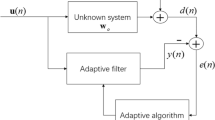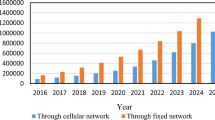Abstract
In this paper, an approximate analytical method for performance analysis of equal gain combiner (EGC) receiver over independent Nakagami and Rician fading channels is presented. We use a convergent infinite series approach which makes it possible to describe the probability of error of EGC receiver in the form of an infinite series. In this paper, we develop a new approximation method for computation of the required coefficients in this series which lets us to derive simple analytical closed-form expressions with good accuracy compared with the exact results existing in the literatures. Our proposed approximation method only needs the mean and the variance of the fading envelope, which are known for various fading distributions, and hence, bypasses the required integration over the fading envelope distribution while computing the required coefficients. This feature lets us to extend our approximation method for performance analysis of EGC receiver over independent Weibull fading channels where the required integration has not any closed-form or tabulated solutions. To give an application of our developed method, we analyze the probability of error of an EGC receiver for binary, coherent PSK (CPSK) modulation over independent Nakagami, Rician and weibull fading channels and study the effect of the fading conditions on the system performance.
Similar content being viewed by others
References
Simon M.K., Alouini M.S. (2000). Digital communication over fading channels (1st ed). New York, Wiley
Abu-Dayya A., Beaulieu N.C. (1994). Microdiversity on Ricean fading channels. IEEE Transactions on Communications 42: 2258–2267
Aalo V.A. (1995). Performance of maximal-ratio diversity systems in a correlated Nakagami-Fading environment. IEEE Transactions on Communications 43: 2360–2369
Beaulieu N., Abu-Dayya A. (1991). Analysis of equal gain diversity on Nakagami fading channels. IEEE Transactions on Communications 39: 225–234
Annamalai A., Tellambura C., Bhargava V.K. (2000). Equal gain diversity receiver performance in wireless channels. IEEE Transactions on Communications 48: 1732–1745
Zhang Q.T. (1999). A simple approach to probability of error for equal gain combiners over Rayleigh channels. IEEE Transactions on Vehicular Technology 48: 1151–1154
Chen Y., Tellambura C. (2004). Performance analysis of l-branch equal gain combiners in equally-correlated Rayleigh fading channels. IEEE Communications Letters 8: 150–152
Hashemi H. (1993). The indoor radio propagation channel. IEEE proceedings 81: 943–968
Adwai N.S. (1988). Coverage prediction for mobile radio systems operating in the 800–900 MHz frequency range. IEEE Transactions on Vehicular Technology 37: 3–72
Sahu P.R., Chaturvedi A.K. (2005). Performance analysis of predetection EGC receiver in Weibull fading channel. Electronics Letters 41(2): 85–86
Alouini, M.-S., & Simon, M. K. (2001). Performance of generalized selection combining over Weibull fading channels. Proceedings of IEEE VTC’01, 1735–1739.
Cheng J., Tellambura C., Beaulieu N.C. (2003). Performance analysis of digital modulations on Weibull fading channels. Proceedings of IEEE VTC’03 1: 236–240
Sagias N.C., Zogas D.A., Karagiannidis G.K., Tombras G.S. (2003). Performance analysis of switched diversity receivers in Weibull fading. Electronics Letters 39: 1472–1474
Sagias N.C., Karagiannidis G.K., Zogas D.A., Mathiopoulos P.T., Tombras G.S. (2004). Performance analysis of dual selection diversity in correlated Weibull fading channels. IEEE Transactions on Communications 52: 1063–1067
Beaulieu N.C. (1990). An infinite series for the computation of the complementary probability distribution function of a sum of independent random variables and its application to the sum of Rayleigh random variables. IEEE Transactions On Communications 38: 1463–1474
Holtzman J.M. (1992). A simple, accurate method to calculate spread-spectrum multiple-access error probability. IEEE Transactions on Communications 40: 461–464
Author information
Authors and Affiliations
Corresponding author
Rights and permissions
About this article
Cite this article
Samimi, H., Azmi, P. An approximate analytical framework for performance analysis of equal gain combining technique over independent Nakagami, Rician and Weibull fading channels. Wireless Pers Commun 43, 1399–1408 (2007). https://doi.org/10.1007/s11277-007-9314-z
Received:
Accepted:
Published:
Issue Date:
DOI: https://doi.org/10.1007/s11277-007-9314-z




